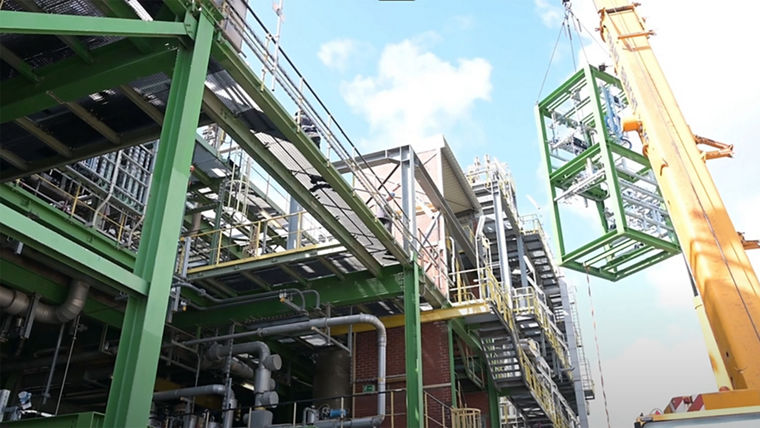"Casting something in steel and iron is the ultimate goal of an industrial researcher," says Robert Franke, head of oxo research at Evonik. His team did just that in the MACBETH project. On a sunny Wednesday morning in the summer of 2023 at the Marl Chemical Park, they watched as a truck-mounted crane lifted three green-painted steel frames the size of sea containers into the oxo plant. Inside was the demonstration plant they had developed.
Although the crane moves the multi-ton loads effortlessly, precision work is required. An assembly worker positions the three giants with pulling ropes. Then two of his colleagues anchor the modules to a steel support frame with screws as thick as thumbs. After that, the piping and cabling between the modules are re-installed, as are the additional connections to the larger plant.
For Franke, a catalysis specialist, it is an exhilarating sight - and the culmination of more than a decade of hard research. The ultimate goal: a new type of reactor that makes important chemical reactions even more energy-efficient.

MACBETH - the largest EU research project coordinated by Evonik
The path to achieving this goal is difficult. The researcher refers to it as a "high-risk project"-not because of the hazardous nature of the chemicals used, but because of the many scientific and technical hurdles that must be overcome before the project can be successfully completed. Twenty-seven collaborators from across Europe have joined forces to work on the new type of reactor. The European Commission is funding the MACBETH (Membranes And Catalysts Beyond Economic and Technological Hurdles) project through October 2024 with a total of €20.7 million as part of its Horizon 2020 framework program. This makes it the largest research project ever coordinated by Evonik.
Shakespeare's drama Macbeth ends tragically-the eponymous main character is dead at the end of the play, as are many of his former confidants. But Franke and his team are working on a happy ending for his namesake at Evonik. The key is a completely new reactor design. Catalytic membrane reactors have already shown that they work in principle on a laboratory scale. MACBETH now aims to overcome the last technical hurdles on the way to larger scales and to prove the economic viability of the approach in industrial practice.
The demonstration plant consists of three modules: "The catalyst preparation station is installed within the first module. It consists of a solid feed and the coating vessel," says Thomas Diehl, technical chemist at Process Technology & Engineering and responsible for process engineering in the MACBETH project. "In the second module, we have integrated the membrane reactor developed for MACBETH and a high-boilers trap for the separation of low-volatility substances. The third module includes a fixed-bed reactor and a heat exchanger.


»From our studies in the pilot plant, we conclude that we can save up to 70% of the energy. That would mean a 35% reduction in CO2 emissions«
Professor Robert Franke Head of oxo research at Evonik
Reduced CO2 emissions
The heart of the MACBETH reactor is a series of monoliths: More than 50 of the gray, broomstick-thick silicon carbide rods, each more than a meter long, are installed inside. Their pores are lined with a coating that contains the actual catalyst. Immobilized in this way, the catalyst is much more stable than in conventional homogeneous processes. An integrated membrane separates the resulting product directly from other components. This eliminates the need for an additional, energy-intensive separation step. "From our studies in the pilot plant, we conclude that we can save up to 70% of the energy. That would mean a 35% reduction in CO2 emissions," says Franke - and adds, being the cautious scientist that he is, "We'll see if that's really the case when we run the demo reactor under production conditions.
The modular design and elimination of the separation step will make the plant much less expensive. Both investment and operating costs could be significantly reduced compared to a conventional plant. "If successful, this will be a revolution for the chemical industry," says Franke.

MODULAR DESIGN SIMPLIFIES INTEGRATION
For Evonik, this is the first time that a modular demonstration plant for a completely new process has been connected directly to a side stream of the production plant. "In the past, such integration during ongoing operations would have been a major challenge for those responsible," says Maren Wagner, who is in charge of engineering for the MACBETH project. "Each sensor and actuator would have had to be wired and connected individually." Thanks to the modular design, Evonik's Technical Service was able to pre-assemble and test the system components elsewhere. "Only then did the Technical Service bring the modules to the actual site and connect them to the existing process control system using the 'plug and produce' method," says Wagner. In this process, the individual components are interconnected via standardized data interfaces to form groups that can then be easily integrated into the control system. This minimizes downtime. Another plus point: After the demonstration phase, the modules can be removed and reused elsewhere.
Whether MACBETH initiator Franke's vision of a revolution in the chemical industry will be realized will be decided in Marl in the coming months. This is where the demonstration plant will undergo its ultimate practical test. It will be supplied with the same material feedstocks as the oxo plant.
"Fundamentally new processes like those in the Macbeth project allow us to make leaps in sustainability and efficiency that we can't achieve just by continuously improving our existing plants," says Benedikt Dercks, Operations Assistant at the oxo plant. "That's why we're happy to contribute our day-to-day production experience to research projects like this."

HYDROFORMULATION TEST CASE
Testing in Marl uses hydroformylation, also known as oxo synthesis, as an example. "In this process, we convert unsaturated hydrocarbons, the olefins, into aldehydes using a mixture of hydrogen and carbon monoxide, the synthesis gas," explains Franke. The reaction is one of the secret stars of the chemical industry: little known outside the industry, but people come into contact with the products it makes possible every day. Every year, some twelve million tons of aldehydes are produced worldwide. They serve as intermediates on the way to higher alcohols, organic acids and esters, which are needed in numerous applications, from pharmaceuticals to plastics.
A special feature of MACBETH is that the unsaturated hydrocarbon used, butene, is obtained from a complex gas mixture, the C4 cut. Together with the synthesis gas, it is converted into n-pentanal by the catalyst immobilized on the monoliths. "In this way, a molecule with four carbon atoms is transformed into one with five such atoms," says Diehl, a process engineer. "Pentanal then has many applications." At Evonik in Marl, for example, it is converted into 2-propylheptanol, which is used as a plasticizer in plastics.
Over the next year and a half, production results and process parameters will be meticulously recorded to determine whether the demonstration plant is robust enough to withstand the rigors of everyday production. Only then will it become clear whether, unlike its literary namesake, MACBETH will have a happy ending.



